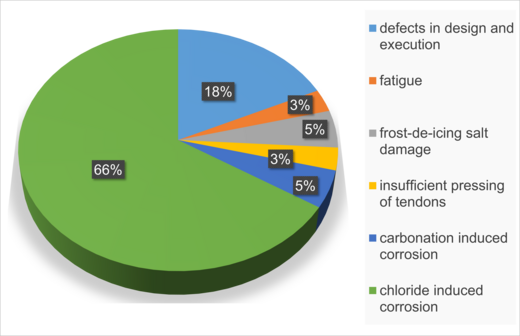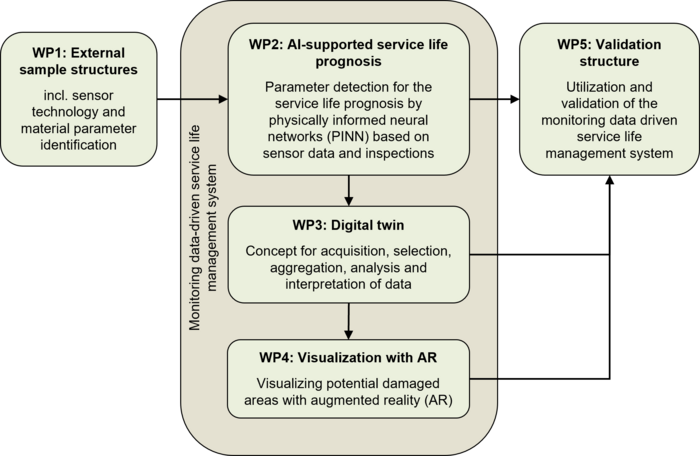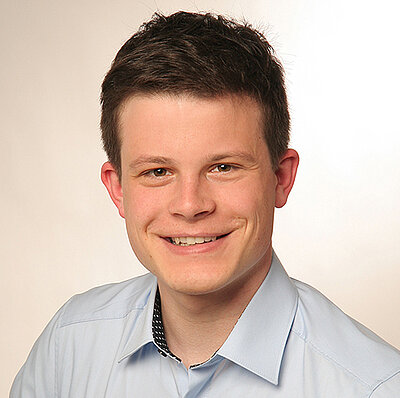Monitoring data-driven service life management with AR based on an adaptive, AI-supported corrosion prognosis for infrastructures made of reinforced concrete under combined influences
There are more than 39,000 bridges in the german federal trunk road network, more than 85% of them are made of reinforced and prestressed concrete. More than half of these engineering structures being 40 to 50 years old (Federal Highway Research Institute (BASt); 2021). Aging, material fatigue and the increased traffic load lead to damage to the building fabric and thereby endanger the reliability and performance of the entire transport system. The proportion of concrete repairs required for damage to bridges and even necessary demolition of structures as a result of chloride-induced reinforcement corrosion is the highest compared to other damage mechanisms, see Figure 1.
In this project, a method is to be researched that allows buildings to be monitored using currently available measurement principles and to provide corresponding time-variant status information for a link within a digital building twin. Approaches to the acquisition, preparation and processing of continuously recorded sensor data from corrosion monitoring and their connection to a digital lifetime management system are examined. The basis for this is an adaptive service life prognosis under combined impact from chloride exposure and mechanical strains and stresses. Selected and interpreted sensor data are used for the regular adaptation of model parameters. Methods of artificial intelligence (AI) should be used both for the interpretation of the local and possibly incorrect sensor data and for the adaptation of the parameters of the prognosis model. In particular, with the help of Physically-Informed-Neural-Networks (PINN), status data is continuously updated and used to adapt the service life prognosis. Model parameters are derived from the locally recorded sensor data, results from additional structural inspections and information on the state of stress, deformation and cracking of the structure, which enable a three-dimensional representation and prognosis of the damage progress. In addition, it is possible to record changes in measured values or correlations due to aging or damage to the concrete or as a result of the degradation of the monitoring system. Selected sensor and prognosis data are linked to a database within a digital twin.
Selected sensor and prognosis data are linked to a database within a digital twin. With the help of the comparison of prognosis data, data on the building geometry and the position of the steel reinforcement in the component, problem areas are to be identified and visualized on the component with the help of augmented reality (AR). In this way, damaged areas that are not yet visible on the surface can be found and checked more easily during building inspections. The adaptive service life prognosis provides a reliable prediction of the damage process and thus enables an optimized and locally differentiated planning of future repair measures.
The project is managed as a cooperation between Dirk Lowke (building materials and building maintenance) and Henning Wessels (data-driven modelling) in order to examine the research questions addressed both with regard to the structural engineering and concrete technology aspects and with regard to artificial intelligence in sufficient depth.
The work program of the research project is divided into 5 work packages. The essence of the research work is the monitoring data-driven service life management system with AR on the basis of an adaptive, AI-supported service life prognosis addressed in WP2, WP3 and WP4, Figure 2.
In WP2, the focus is initially on the preparation and processing of the continuously recorded sensor data for the adaptive service life prediction with the help of PINN’s. This enables reliable assignment and interpretation of the sensor data on the basis of a physically-based model. The acquisition of the sensor data for the training of the PINN’s takes place on external sample structures with precisely known concrete technological and physical characteristics as well as specifically controlled coupled effects of chloride exposure and load, which are designed and built in WP1. WP3 and WP4 address the investigations into linking sensor and model data with a digital twin and research into methods for visualizing the data on the building using AR. Finally, the validation and application of the research work should take place in WP5 at the central SPP-2388 validation building.
Contact
Publications
Publications
[Ull21] Ullmann, Stefan; Lowke, Dirk: Effect of Young's Modulus on the degradation of repair mortars chloride migration resistance under coupled loading conditions. In: Int. RILEM Conference Microstructure Related Durability of Cementitious Composites, 2021, The Hague, Netherlands, Bd. 4., resolver.tudelft.nl/uuid:1530eaec-7575-4ebb-bb89-80ea9a785cbd
[Men20] Mengel, L.; Krauss, H.W.; Lowke, D.: Water transport through cracks in plain and reinforced concrete–Influencing factors and open questions. Construction and Building Materials 254, 118990
[Thi16] Thiel, C.; Beddoe, R.E.; Lowke, D.; Gehlen, C.: Investigating the role of moisture on concrete carbonation using single-sided 1H-NMR.2016, Int. RILEM Conference Materials, Systems and Structures in Civil Engineering 2016, S. 261-268
[Mil12] Milachowski, C.; Lowke, D.; Gehlen, D.: Detection of transport processes during freeze-thaw deicing salt attack using single-sided NMR. Proc. of 2nd Conference on Microdurability, Amsterdam, 11.-14.04. 2012
[Low08] Lowke, D.; Schmidt, K.; Schießl, P.; Heinz, D.: Dauerhaftigkeitspotentiale selbstverdichtender Betone: Auswirkungen der Betonzusammensetzung auf Dichtigkeit, Carbonatisierung, Frostwiderstand und Alkali‐Kieselsäure‐Reaktion. Beton‐und Stahlbetonbau 103(2008)5, S.324-333
[Dre15] Dreßler, Inka; Wichmann, Hans-Joachim; Budelmann, Harald (2015): Korrosionsmonitoring von Stahlbetonbauwerken mit einem funkbasierten Drahtsensor. Bautechnik 92(2015)10, S. 683–687. DOI: 10.1002/bate.201500051.
[Hol10] Holst, Alexander; Budelmann, Harald; Wichmann, Hans-Joachim (2010): Korrosionsmonitoring von Stahlbetonbauwerken als Element des Lebensdauermanagements. Beton- und Stahlbetonbau 105(2010)12, S. 536–549. DOI: 10.1002/best.201000066.
[Wes10] Wessels, Henning, Christian Weißenfels, and Peter Wriggers. "The neural particle method–an updated Lagrangian physics informed neural network for computational fluid dynamics." Computer Methods in Applied Mechanics and Engineering 368 (2020): 113127.
[Hen21] Henkes, Alexander, Wessels, Henning, & Mahnken, Rolf. (2021): Physics informed neural networks for continuum micromechanics. In Proceedings in Applied Mathematics and Mechanics.
Period
First Phase: 10/2022 - 09/2025









